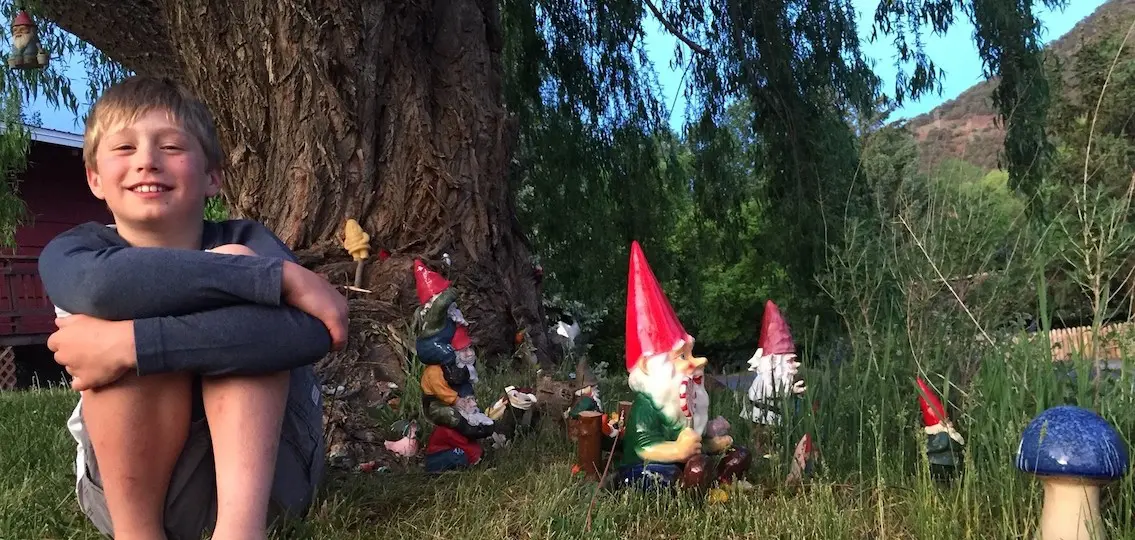Up the airy mountain,
Down the rushy glen,
We daren’t go a-hunting,
For fear of little men;
Wee folk, good folk,
Trooping all together;
Green jacket, red cap,
And white owl’s feather!
—from The Fairies, by William Airingham

Collecting gnomes wasn’t just a hobby for my son Elias before he became a middle-schooler; it was a way of life. In the morning, he would don his bathrobe and check on the gnome-home he built under a Juniper bush. He would leave notes and receive them in return. When one of his goldfish died, the gnomes sent a conciliatory card. He responded with a drawing of a house shaped like a mushroom and a smiling face: “Your note did cheer me up, and I will be fully cheered-up soon. Thank you for all your kindness. You are very good friends of mine. You make my life awesome.”
Gnomes are the diminutive, pointy-red-hatted custodians of the natural world: master farmers, animal doctors, vegetarians, they have names like Geronimus B and Thelonious. They are kind and quiet and decent. In these fractured times, they connect us back to what we care about and what makes us happy: a place-based life that integrates landscape with community.
By chance, a reporter for a national publication wrote about Elias’s growing collection. Overnight, he became famous.
Shortly, packages began to arrive, wrapped in twine as if from across the ages, addressed in shaky penmanship. They contained not the bombs or anthrax I had presumed, but gnomes, and notes. Many began: “I live alone. After my husband died…” They recalled days past, telling stories of cross-country journeys to live with children, of loss, of unspoken but implied loneliness—“I wish my children were little again”— signed with names several generations past: Marva. Eunice. Arnie.
A professional gnome-carver from Ohio sent Elias a custom figurine clearly intended as a talisman: “This good luck gnome eats little, drinks less but only water, is house broken, dances and sings occasionally, and wears indoor-outdoor finish… best of all he has the power to give his master the confidence to take on difficult tasks and be successful.”
An 82-year-old woman from North Carolina still sends cards to “Her little gnome, Elias,” on holidays. When I received emails asking for Elias’s address from gnome lovers, I shared it without thinking, only to be scolded by my wife Ellen, who warned me about the modern world’s impure intentions. “But,” I protested, “these are the best people on earth!”
One such correspondence led Ellen to a prearranged meeting in a Starbucks’ parking lot, where a woman named Patricia handed off two cement gnomes, lifted from the trunk of her green Citation. The transaction felt illicit—trafficking in humanity in the early twenty-first century.
Improbable human connection is the domain of the gnome.
They seem to answer in the affirmative to Bruce Springsteen’s plaintive call of alienation: “Is there anyone alive out there?” And Elias’s experience shows they may foster a broader community than we might otherwise be capable of making. It takes courage to find kinship, but these guys seem to have it dialed.
The largest of our gnomes, named Candy for the giant spiral lollypop he holds, still sits underneath the Willow in our front yard. Candy presides over the commonweal, observing the adumbration of the mountains each dusk and dawn, taking delight in the piercing winter stars, bearing silent witness to passing neighbors, and comforting, by presence, the deer and wild turkeys that wander by. If he could speak, he would cite the poet Mary Oliver: “Sometimes I need only to stand wherever I am to be blessed.”
But blessedness doesn’t always arrive unbidden, and like luck, sometimes you need to create your own. That’s why one of my first acts as a town councilman in Basalt, Colorado, was to create a Gnome Home Building Ordinance, establishing districting in the park by the river outside the library.
It gives residents permission to gather in one peaceful and beautiful place and build, out of natural materials, model homes for a special kind of creature: kindly and yet open to cross-boundary conversation, connected to place and nature, deeply rooted in community. A species that can console children, make their lives “awesome,” and take care of the lonely with companionship. Gnomes are quiet, calm, and listening; some might call their ambition provincial, but their aspirations are in fact as sacred and urgent as scripture.
Of course, nothing lasts.
Elias determined that leprechauns weren’t real when he found St. Patrick’s Day supplies in Ellen’s closet. The demise of Darby O’Gill was the domino that took out Santa, the Easter bunny, and in widening carnage, gnomes, and even the tooth fairy.
Now, a seventh grader, Elias doesn’t even like to talk about gnomes, embarrassed by his past. But who of us is not? When I buy a gnome welcome-mat for my backyard office, Elias says, “It makes me feel bad.”
“Really, bad?” I ask. “But gnomes are so cool.”
“Not bad, weird.”
I try to explain. While gnomes may not actually come out at night and cure animals, surely there’s a reason most cultures—from the Ojibwe to the Norse, have for millennia told stories of little people, spirits in the woods: Tomtins, Pixies, Tommyknockers, Browines, Nunupi. They are about something inside us.
“In that sense,” I continue, as he looks past me into the near distance, “gnomes are as real as any human idea, as…” And I pause and trail off. We are silent for a moment.

“Should we play catch?” Elias asks.
And I say yes.




